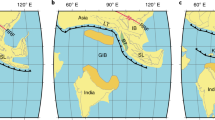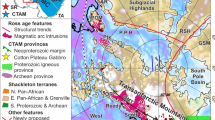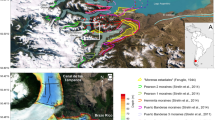Abstract
THE geometrical fit of Madagascar against India has been widely accepted in most reconstructions of Gondwanaland1. This fit is consistent with Precambrian trends, lithologies and age provinces2,3. Palaeomagnetic data also support the general fit of Madagascar against India4, and there are suggestions that this reassembly can be recognised as far back as Proterozoic times5. The exact fit of east Madagascar and west India has not been adequately defined. Recent knowledge of the Precambrian geology and tectonics, has now allowed the possibility of better defining this fit, mainly on the basis of matching Precambrian re-entrant lineaments. The east coastline of Madagascar is a rectilinear feature, with a narrow shelf of 25–50 km and an abrupt steep break in slope after the 1,000-m isobath. The proposed opposing coastline of west India is also rectilinear with a wider shelf of 100 km and a shelf break down to the 1,000-m isobath. The 1,000-m isobath of India was receded towards the coastline by removing the post drift sediments, according to the best available sections6. A 1:2,500,000 conical projection was used to prepare a distortion-free, equidistance base map of both Madagascar and India (Fig. 1).
This is a preview of subscription content, access via your institution
Access options
Subscribe to this journal
Receive 51 print issues and online access
$199.00 per year
only $3.90 per issue
Buy this article
- Purchase on Springer Link
- Instant access to full article PDF
Prices may be subject to local taxes which are calculated during checkout
Similar content being viewed by others
References
Smith, A. G. & Hallam, A. Nature 225, 139 (1970).
Katz, M. B. Geology 2, 237 (1974).
Crawford, A. R. Tectonophysics 22, 141 (1974).
Embleton, B. J. J. & Valencio, D. A. Tectonophysics 40, 1 (1977).
Piper, J. D. A. Phil. Trans. R. Soc. A280, 469 (1976).
Eremenko, N. A. & Negi, B. S. Tectonic Map of India (Oil Nat. Gas Commn., 1968).
Swami Nath, J., Ramakrishnan, M. & Viswanath, M. N. Rec. geol. Surv. India 107, 149 (1976).
Besaire, H. Serv. geol. Madagascar XXXIX (1966).
Premoli, C. Carte Tectonique de Madagascar (1977).
Katz, M. B. Geol. Mag. 115, 237 (1978).
Crawford, A. R. J. geol. Soc. India 19, 144 (1978).
Katz, M. B. J. geol. Soc. India 19, 185 (1978).
Premoli, C. Int. atom. Energy Ag. Meeting, Lusaka (1977).
Grady, J. C. J. geol. Soc. India 12, 56 (1971).
Srinivasan, R. & Sreenivas, B. L. J. geol. Soc. India 18, 589 (1977).
Fyfe, W. S. & Leonardos, O. H. Jr Nature 244, 501 (1973).
Author information
Authors and Affiliations
Rights and permissions
About this article
Cite this article
KATZ, M., PREMOLI, C. India and Madagascar in Gondwanaland based on matching Precambrian lineaments. Nature 279, 312–315 (1979). https://doi.org/10.1038/279312a0
Received:
Accepted:
Issue Date:
DOI: https://doi.org/10.1038/279312a0
This article is cited by
-
Modeling the Crust and Upper Mantle Applying an Optimization Method to Multiple Datasets: Surface Wave Dispersion, P-Receiver Function, and S-Waveform
Pure and Applied Geophysics (2023)
-
Stratigraphic and sedimentological attributes in Hazara Basin Lesser Himalaya, North Pakistan: their role in deciphering minerals potential
Arabian Journal of Geosciences (2015)
-
A new perspective on the significance of the Ranotsara shear zone in Madagascar
International Journal of Earth Sciences (2010)
Comments
By submitting a comment you agree to abide by our Terms and Community Guidelines. If you find something abusive or that does not comply with our terms or guidelines please flag it as inappropriate.



